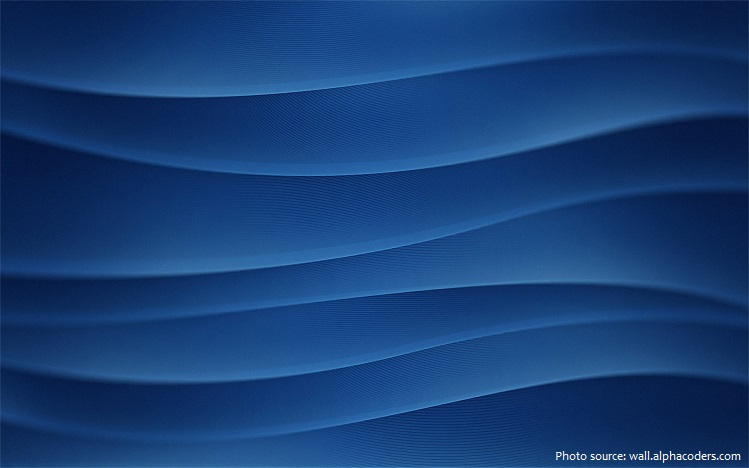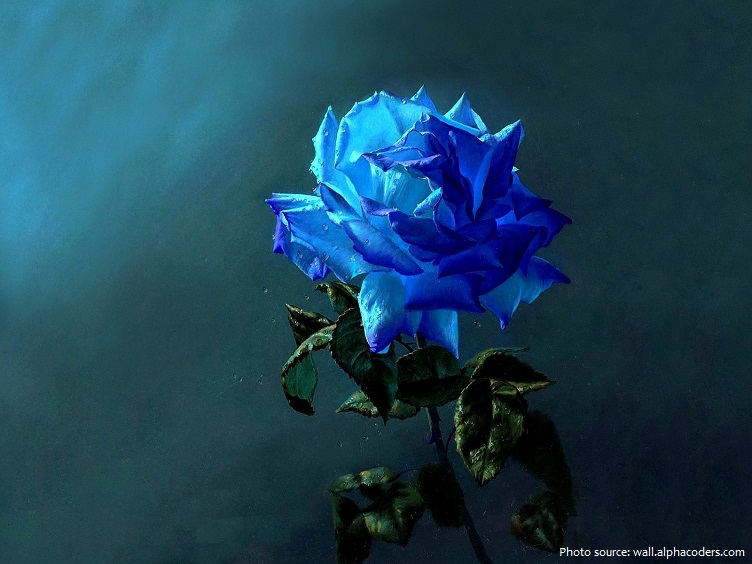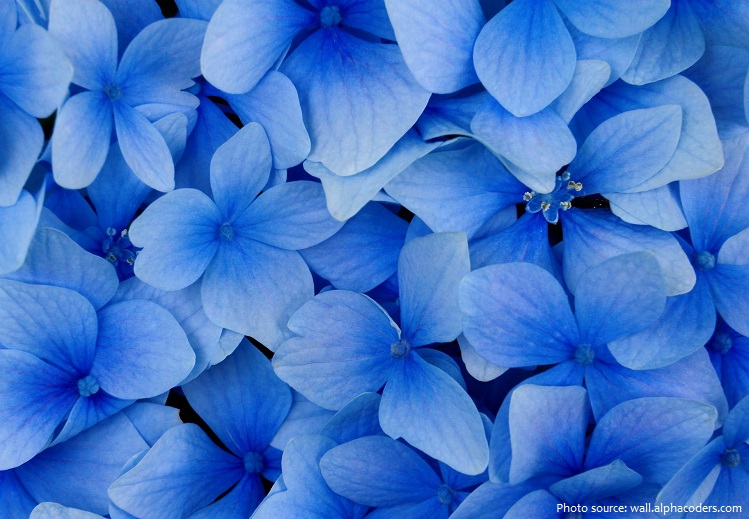
Blue is one of the three primary colours in painting.
It is associated with two of Earth’s greatest natural features: the sky and the ocean.
Blue is one of the seven colors of the rainbow along with red, orange, yellow, green, indigo and violet.
It has been an important colour in art and decoration since ancient times.
However, blue was a latecomer among colours used in art and decoration, as well as language and literature. Reds, blacks, browns, and ochres are found in cave paintings from the Upper Paleolithic period, but not blue. Blue was also not used for dyeing fabric until long after red, ochre, pink and purple. This is probably due to the perennial difficulty of making good blue dyes and pigments. The earliest known blue dyes were made from plants – woad in Europe, indigo in Asia and Africa, while blue pigments were made from minerals, usually either lapis lazuli or azurite.

Lapis lazuli, a blue semi-precious stone, has been mined in Afghanistan for more than three thousand years, and was exported to all parts of the ancient world. Egyptians used chemistry to combine the rare lapis with other ingredients, such as calcium and limestone, and generate other saturated blue pigments. It was at this time that an Egyptian word for “blue” emerged.
Beginning in about 2500 BC, the ancient Egyptians began to produce their own blue pigment known as Egyptian blue by grinding silica, lime, copper, and alkalai, and heating it to 800 or 900 °C (1,470 or 1,650 °F).
Blue was not one of the four primary colours for Greek painting described by Pliny the Elder (red, yellow, black, and white), but nonetheless it was used as a background colour behind the friezes on Greek temples and to colour the beards of Greek statues.

Blue was considered the colour of mourning, and the colour of barbarians.
Julius Caesar reported that the Celts and Germans dyed their faces blue to frighten their enemies, and tinted their hair blue when they grew old.
Dark blue was widely used in the decoration of churches in the Byzantine Empire. In Byzantine art Christ and the Virgin Mary usually wore dark blue or purple. Blue was used as a background colour representing the sky in the magnificent mosaics which decorated Byzantine churches.
In the art and life of Europe during the early Middle Ages, blue played a minor role. The nobility wore red or purple, while only the poor wore blue clothing, coloured with poor-quality dyes made from the woad plant.

In about the 9th century, Chinese artisans abandoned the Han blue colour they had used for centuries, and began to use cobalt blue, made with cobalt salts of alumina, to manufacture fine blue and white porcelain, The plates and vases were shaped, dried, the paint applied with a brush, covered with a clear glaze, then fired at a high temperature. Beginning in the 14th century, this type of porcelain was exported in large quantity to Europe where it inspired a whole style of art, called Chinoiserie. European courts tried for many years to imitate Chinese blue and white porcelain, but only succeeded in the 18th century after a missionary brought the secret back from China.
While blue was an expensive and prestigious colour in European painting, it became a common colour for clothing during the Renaissance. The rise of the colour blue in fashion in the 12th and 13th centuries led to a blue dye industry in several cities, notably Amiens, Toulouse, and Erfurt.
Blue had first become the high fashion colour of the wealthy and powerful in Europe in the 13th century, when it was worn by Louis IX of France, better known as Saint Louis.

The modern blue business suit has its roots in England in the middle of the 17th century. Following the London plague of 1665 and the London fire of 1666, King Charles II of England ordered that his courtiers wear simple coats, waistcoats and breeches, and the palette of colours became blue, grey,
white and buff. Widely imitated, this style of men’s fashion became almost a uniform of the London merchant class and the English country gentleman.
In Renaissance paintings, artists tried to create harmonies between blue and red, lightening the blue with lead white paint and adding shadows and highlights. Raphael was a master of this technique, carefully balancing the reds and the blues so no one colour dominated the picture.
During the 17th and 18th centuries, chemists in Europe tried to discover a way to create synthetic blue pigments, avoiding the expense of importing and grinding lapis lazuli, azurite and other minerals.
The 18th century saw the widespread use of blue military uniforms.

At the beginning of the 20th century, many artists recognised the emotional power of blue, and made it the central element of paintings.
In fashion blue, particularly dark blue, was seen as a colour which was serious but not grim. In the mid-20th century, blue passed black as the most common colour of men’s business suits, the costume usually worn by political and business leaders. Public opinion polls in the United States and Europe showed that blue was the favourite colour of over fifty per cent of respondents. Green was far behind with twenty per cent, while white and red received about eight per cent each.
In 1873, a German immigrant in San Francisco, Levi Strauss, invented a sturdy kind of work trousers, made of denim fabric and coloured with indigo dye, called blue jeans. In 1935, they were raised to the
level of high fashion by Vogue magazine. Beginning in the 1950s, they became an essential part of uniform of young people in the United States, Europe, and around the world.

With the dawn of the World Wide Web, blue has become the standard colour for hyperlinks in graphic browsers (in most browsers, links turn purple after visiting their target), to make their presence within text obvious to readers.
Blue is a very prominent colour on earth. But when it comes to nature, blue is very rare. Less than 1 in 10 plants have blue flowers and far fewer animals are blue.
Most blues contain a slight mixture of other colours – azure contains some green, while ultramarine contains some violet.
Blue is associated with Christianity in general and Catholicism in particular, especially with the figure of the Virgin Mary.

The color was used for the eyebrows on the funeral mask of King Tutankhamun.
In the English language, blue often represents the human emotion of sadness, for example, “He was feeling blue”.
In physics, blue light is in the range of 450–495 nanometres in the visible spectrum. After violet, blue is the spectral region with the shortest wavelengths discernible to the human eye.
The clear daytime sky and the deep sea appear blue because of an optical effect known as Rayleigh scattering. The effect is named after the nineteenth-century British physicist Lord Rayleigh (John William Strutt), is the predominantly elastic scattering of light or other electromagnetic radiation by particles much smaller than the wavelength of the radiation. For light frequencies well below the resonance frequency of the scattering particle (normal dispersion regime), the amount of scattering is inversely proportional to the fourth power of the wavelength.

An optical effect called Tyndall scattering explains blue eyes. The effect is light scattering by particles in a colloid or in a very fine suspension. It is similar to Rayleigh scattering, in that the intensity of the scattered light is inversely proportional to the fourth power of the wavelength, so blue light is scattered much more strongly than red light. An example in everyday life is the blue colour sometimes seen in the smoke emitted by motorcycles, in particular two-stroke machines where the burnt engine oil provides these particles.
Distant objects appear more blue because of another optical effect called aerial perspective.